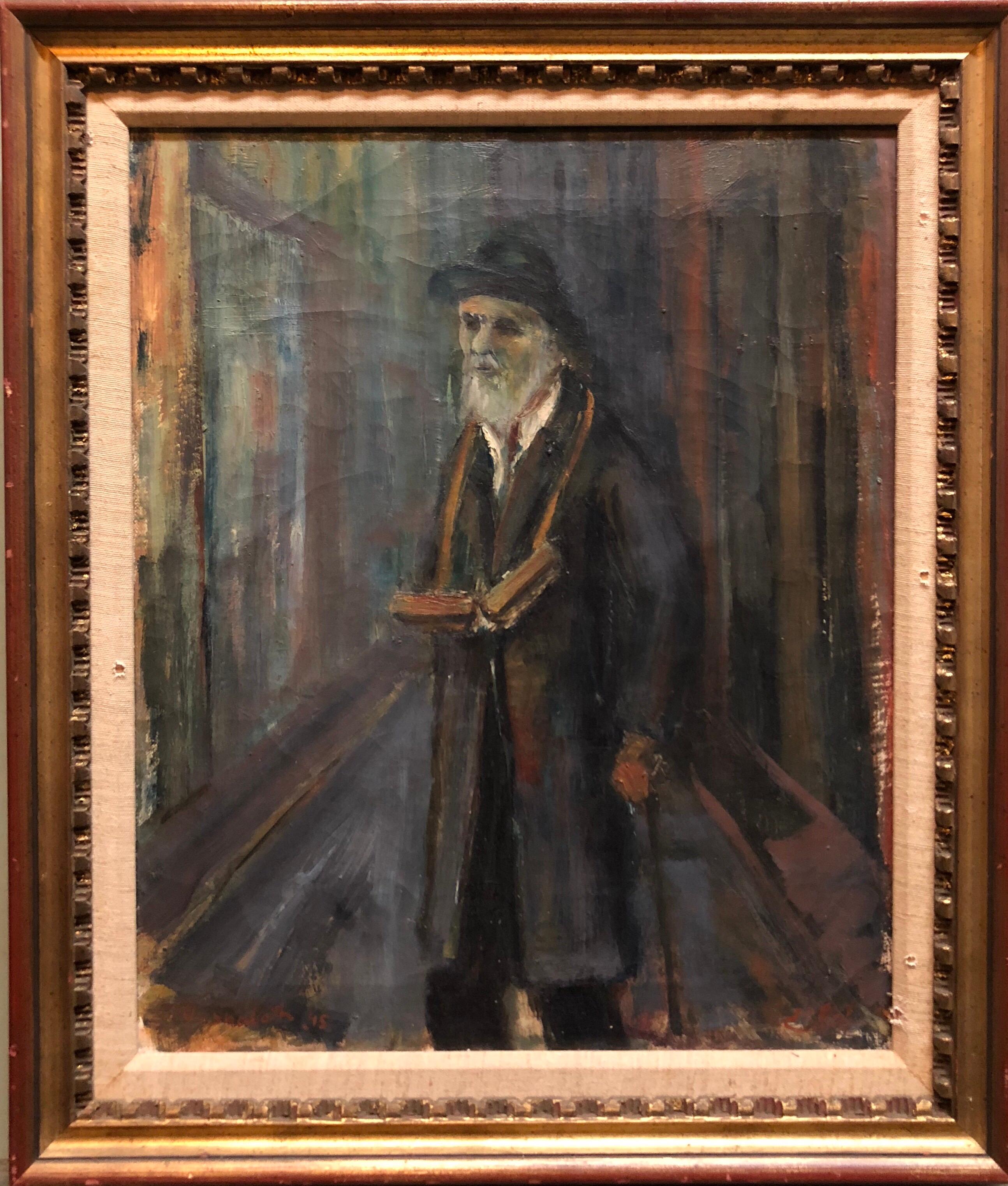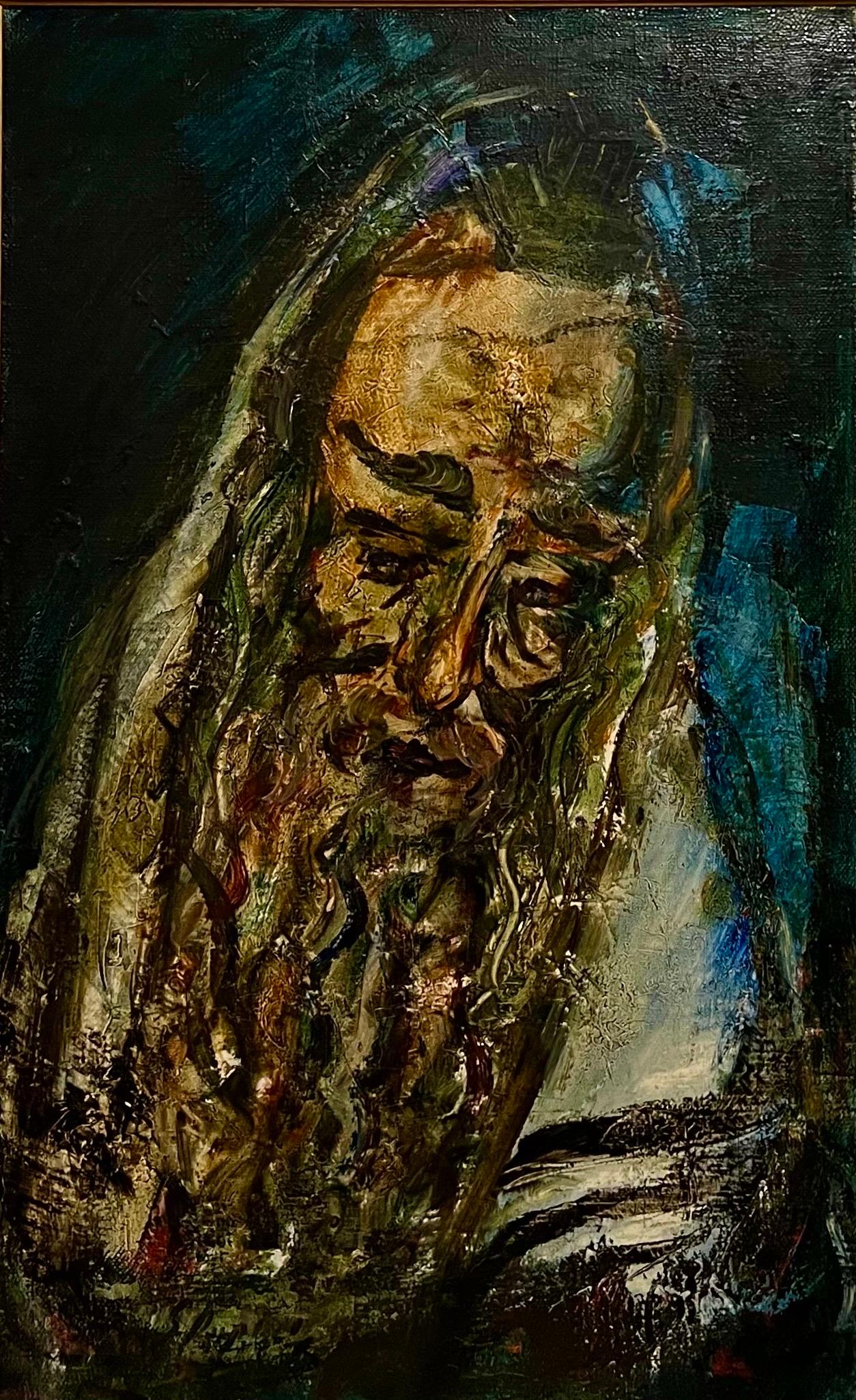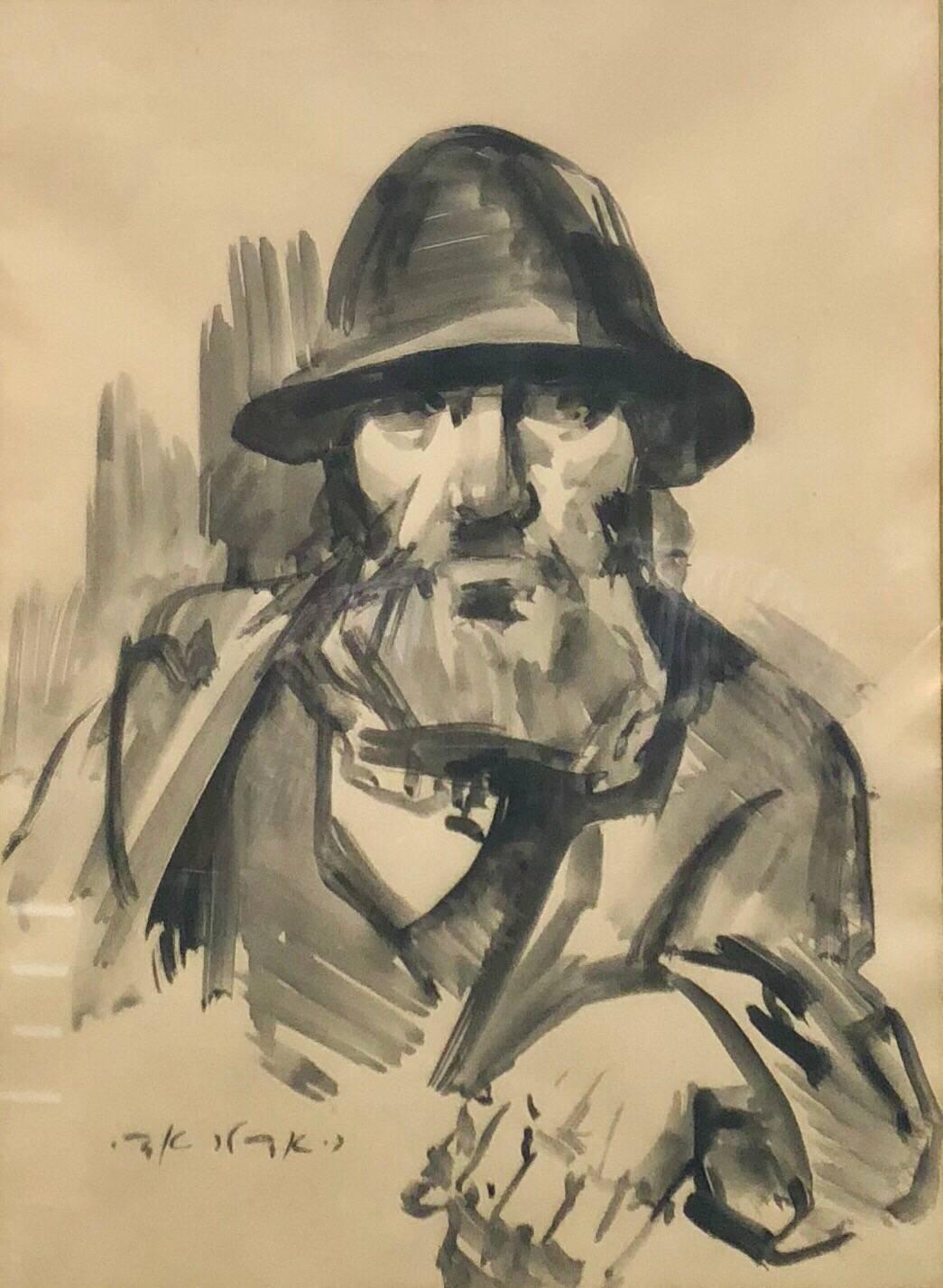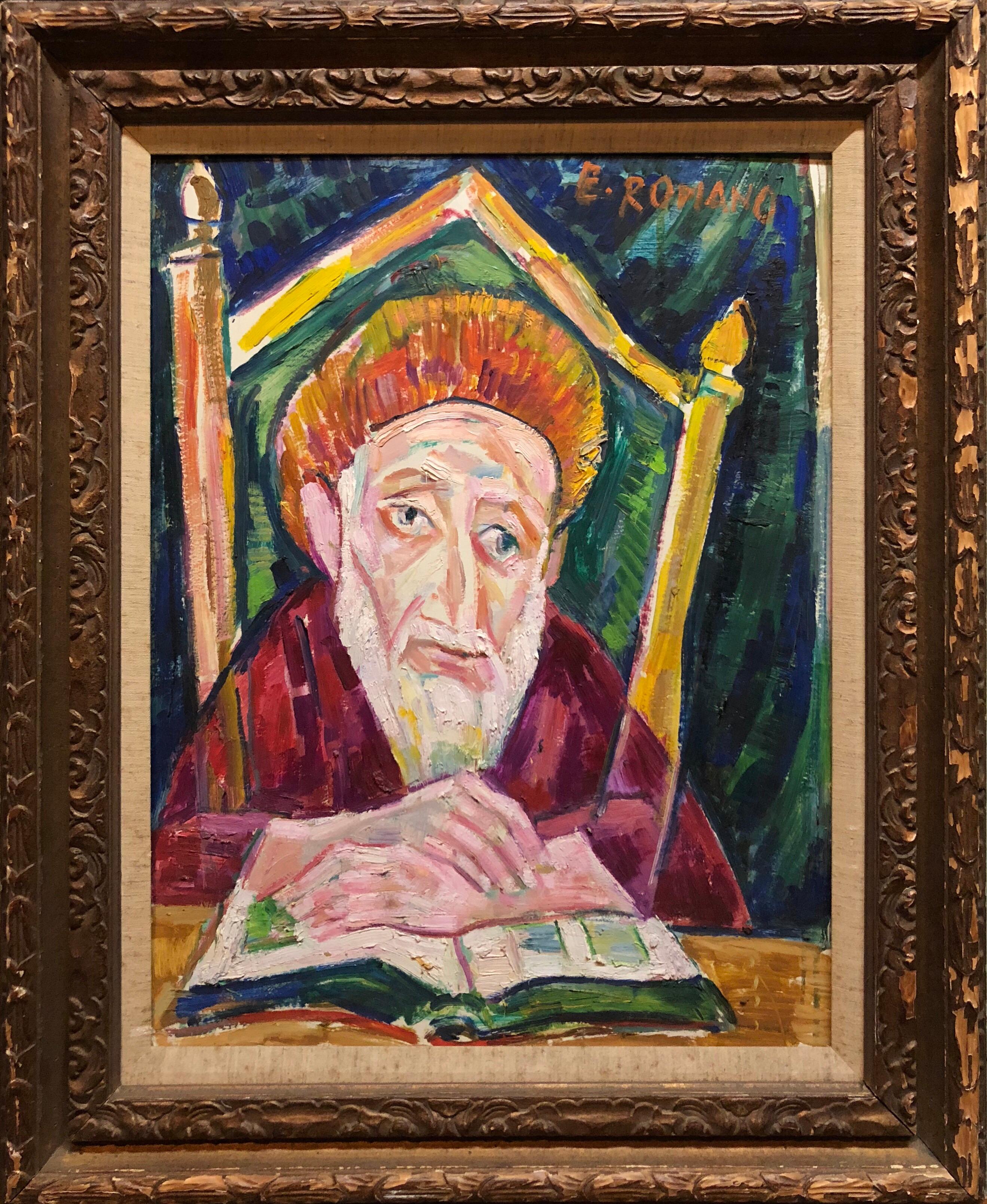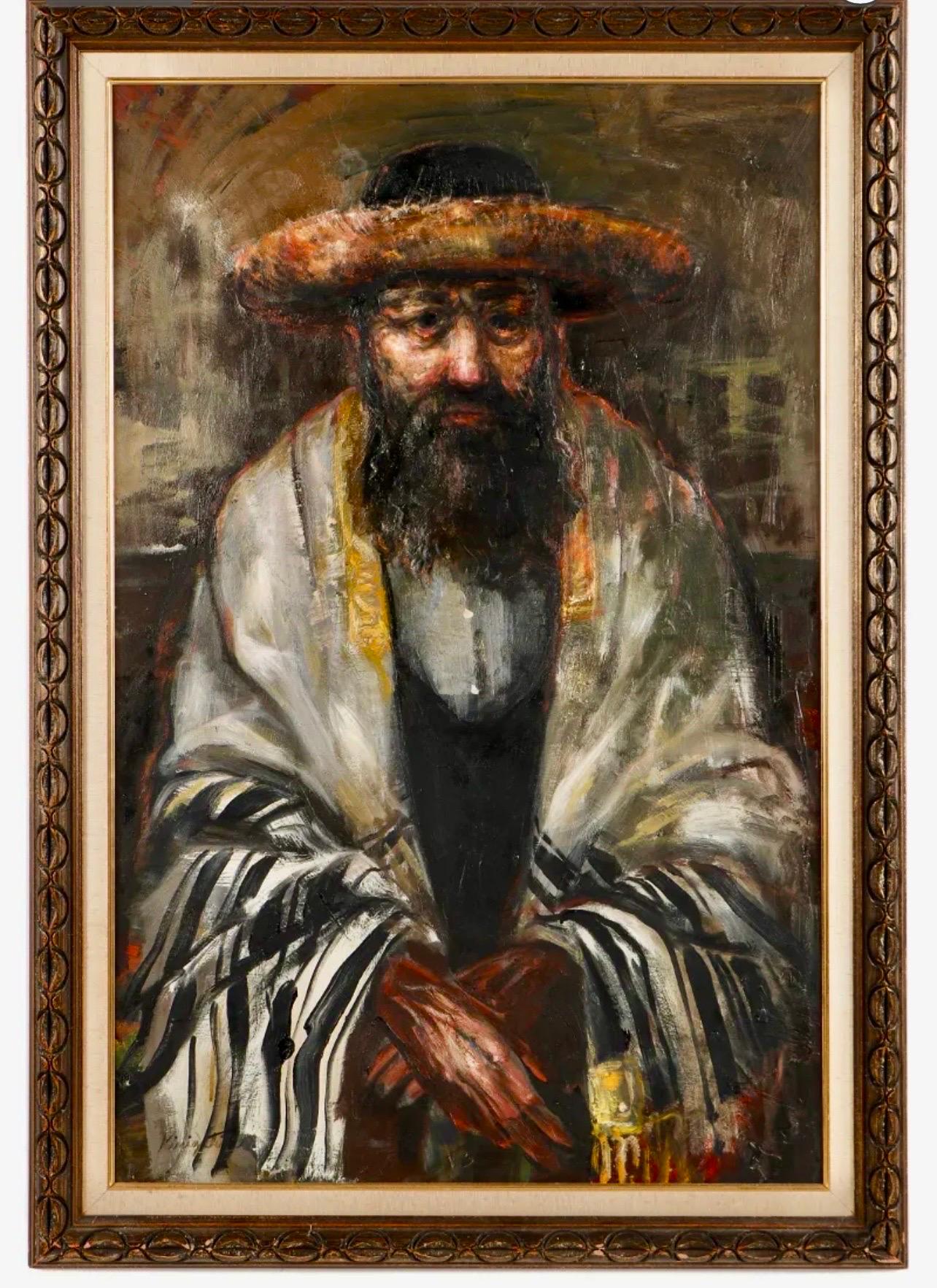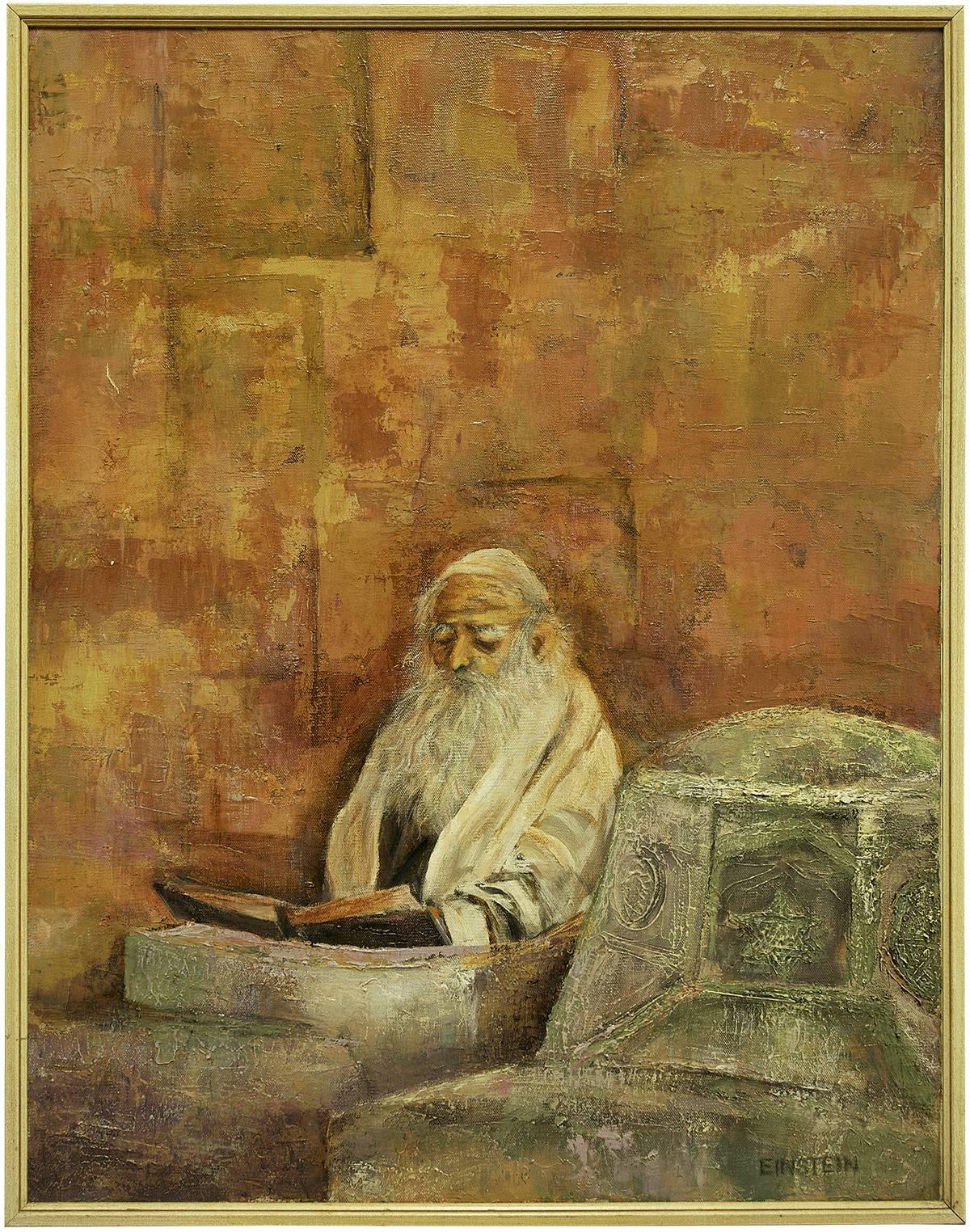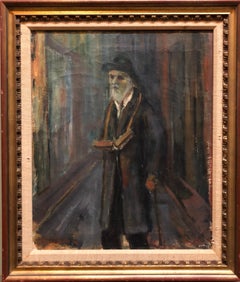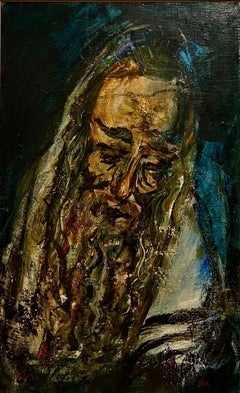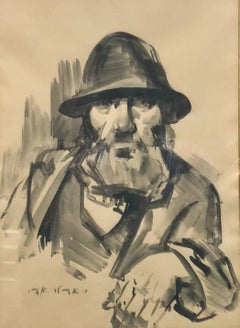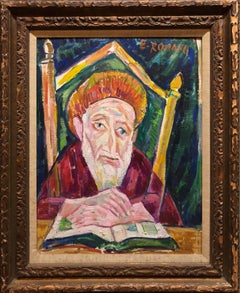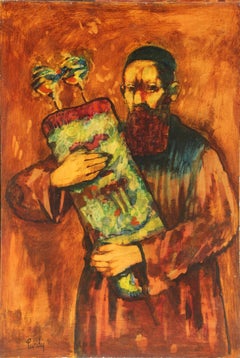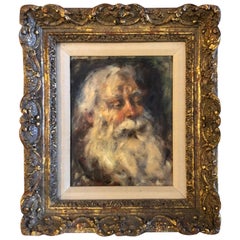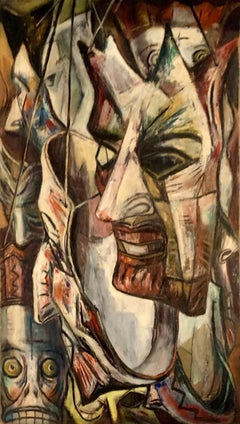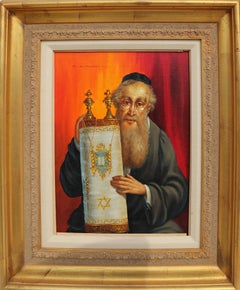Items Similar to Rare 1946 WWII Judaica Abstract Oil Painting Nahum Tschacbasov WPA Artist Rabbi
Want more images or videos?
Request additional images or videos from the seller
1 of 16
Nahum TschacbasovRare 1946 WWII Judaica Abstract Oil Painting Nahum Tschacbasov WPA Artist Rabbi1946
1946
$4,800
£3,672.04
€4,223.27
CA$6,855.01
A$7,556.09
CHF 3,904.29
MX$90,327.77
NOK 49,115.65
SEK 46,161.72
DKK 31,544.14
About the Item
Nahum Tschacbasov
Russian American, 1899-1984
Portrait of a Jewish Man, Rabbi
Oil on canvas
Hand signed and dated upper right. Unframed
Canvas 44 x 26.75 in
Provenance: Stuttman Gallery (bears label verso)
Esther Stuttman ran an influential gallery that showed Louise Nevelson, Jacob Kainen. Yvonne Thomas, Eugene Stuttman, along with Richard Benson, John Deeks, Garry Winogrand, Catherine Carine, Kathleen Caraccio, Richard Kenerson, John Berg, and Lee Friedlander.
Nahum Tschacbasov was born in Baku, in the southeast of Russia. When he was eight years old, he came to America, where his family settled in Chicago. His career, spanning more than five decades from the 1930’s to the 1980’s, is a kaleidoscope of influences, from modernism to the Byzantine style and expressionism of his Russian roots.
Tschacbasov’s paintings of the 1930’s reflect the social and political preoccupations of the times. He received considerable critical attention for his powerful dramatic satirical depiction of social injustice.
In the 1940’s he gained wider recognition when his style evolved into a fusion of Cubism and Surrealism. Through the influence of Jung, as well as currents brought to America by the newly arrived group of European Surrealists, he created a powerful personal iconography in which the inner workings of the psyche are revealed as myth and metaphor.
His first encounters with modern art are the works of Cezanne, Van Gogh, and Rouault. 1932-33 Tschacbasov moves for a short time to New York City in order to be in a modern art center and then to Paris, where he adopts the name Tschacbasov, an anagram of different family names. He studies with Leopold Gottlieb for eight months, then with Marcel Gromaire, who teaches him pictorial structure, and briefly with Fernand Leger. Working in his studio on the edge of Montmartre and later in the Hotel de Sante in Montparnasse, he produces a large body of work, retaining fifty paintings. After trips to North Africa, Spain, and the Balearic Islands, he travels often from Paris to New York City, where he spends six months painting a series of Depression-inspired pictures after finding that his American business has gone bankrupt in his absence. 1934 In Paris, Galerie Zak exhibits landscapes from his trip to Majorca in the first one-man exhibition of Tschacbasov paintings; Salon de Tuileries also exhibits his work. His savings exhausted, he returns to New York via Tunisia in the midst of the Depression. 1935 Living on Pineapple Street in Brooklyn Heights, Tschacbasov works on the WPA Federal Arts Project, Easel Division, where he meets other artists and becomes politically involved. His works are shown at Galerie Secession with those of Mark Rothko, Adolph Gottlieb, and other modernist and expressionist painters. Tschacbasov, Rothko, Gottlieb, Joseph Solman and others from Galerie Secession form a group called The Ten combining common aims of social consciousness with an expressionist and abstract style. Themes of social injustice are more dominant in Tschacbasov's work than in that of others of The Ten, as he draws on his own childhood experiences of the harsh realities of immigrant life in industrial Chicago. In the summer, a one-man exhibition of his non-objective paintings is held at Galerie Secession, and in December, Montross Gallery in New York City holds the first exhibition of The Ten, including two works by Tschacbasov, "Handout" and "Three Graces." 1936 In January, an exhibition of The Ten is held at Municipal Art Galleries in New York City, and later in the fall an exhibition, also of The Ten, is held at Galerie Bonaparte in Paris. 1936-38 Among the paintings exhibited in the "Annual Exhibition of Contemporary American Painting" at the Whitney Museum of American Art are Tschacbasov's "Deportation", "Clinic", "Friday Night", "Harbor Sunset", and "The Matriarch". 1936-37 Tschacbasov is appointed business manager of Art Front Magazine, a publication associated with the Artists' Union. His circle of friends at this time include Philip Evergood, Milton Avery, Stuart Davis, David Burliuk, William Gropper, the Moses and Rapahel Soyer , Robert Gwathmey, Marsden Hartley, and Max Weber. Due to cut-backs in WPA funding, he teaches at his 38 West 22nd Street studio and at the American Artists' School. On the faculty are David Burliuk and the Soyer brothers, as well as Elaine de Kooning and other artists with similar aesthetic and social points of view. Personal and artistic crises lead to his entering into Jungian psychoanalysis, which provides new impetus and direction to his painting. Under the influence of analysis, he starts to write portions of a surrealistic autobiography, The Moon is My Uncle. His paintings, "Refugees" and "Friday Night" are shown with works by Milton Avery, David Burliuk, and DeHirsh Margules in a group exhibition at Albright Art Gallery in Buffalo, New York. In September, the Berkshire Museum in Pittsfield, Massachusetts focuses on themes of social criticism in an exhibition entitled "The World Today", curated by Elizabeth McCausland, which includes Tschacbasov's, "Little Red School House". 1940 Tschacbasov takes up photography. Photographing the works of friends and other artists, he builds a collection of color slides which serves as a foundation for the American Library Color Slide Company, an archives which continues to be of service in art history education. His painting, "Portrait of Sondra" is exhibited in the "Second Biennial Exhibition of Contemporary American Paintings" with works by the Soyer brothers, John Sloan, and others at the Virginia Museum of Fine Arts in Richmond. 1941 Tschacbasov exhibits at the Pennsylvania Academy of Fine Art in Philadelphia. 1942 Now living at 1 Christopher Street in New York City and painting in his studio at 30 East 14th Street, Tschacbasov participates in "Artists for Victory", an exhibition of contemporary art at the Metropolitan Museum of Art, exhibiting his painting "Deportation". 1943 Tschacbasov's painting style changes from social criticism to themes that are personal and symbolic, leading to a break with the ACA Gallery. He spends part of the year living and working in Oklahoma City, where nature and the landscapes of Oklahoma serve as subjects for his painting. In the 54th Annual Exhibition of American Paintings and Sculpture held at the Art Institute of Chicago, his painting, "Deportation" is exhibited. He re-locates his studio and residence to the Chelsea Hotel, a West 23rd Street haven for artists, where he remains throughout the rest of his life. 1944 Tschacbasov works at Stanley William Hayter printmaking workshop, Atelier 17, a center for surrealist ideas., the Metropolitan Museum of Art in New York City acquires his painting, "Deportation". A one-man exhibition of his works is held at the Arts and Crafts Club in New Orleans. 1945-46 Children's Holiday Circus of Modern Art, at Museum of Modern Art, December 4, 1945-January 6, 1946. Works sent by Perls Galleries. "The Aquarium," "Little Girls' Wonderland" 1944-48 Tschacbasov has four one-man exhibitions at Perls Gallery in New York City and participates in three group exhibitions. 1945 His painting, "The Admiral" is exhibited at the Art Institute of Chicago. Critic Harriet Loveman chooses his painting, "Sondra and the Solar System" for "The Critics' Choice of Contemporary American Painting" exhibition held at the Cincinnati Art Museum. His painting, "Rabbi in White" is shown in a group exhibition, "American Artists for Israel", at the Jewish Museum. 1983 Tschacbasov participates in a group exhibition entitled "The Expressionist Vision, A Central Theme in New York in the 1940's. Paintings exhibited are "Landscape and Trees", "Flower Port", "The Four Muses", and "The Matriarch". Other artists exhibited include Max Weber, Marsden Hartley, Abraham Rattner, David Burliuk, and Jack Levine. 1984 Tschacbasov dies on February 18 in New York City.
- Creator:Nahum Tschacbasov (1899-1984, American)
- Creation Year:1946
- Dimensions:Height: 40 in (101.6 cm)Width: 30 in (76.2 cm)
- Medium:
- Movement & Style:
- Period:
- Condition:Refer to photos.
- Gallery Location:Surfside, FL
- Reference Number:1stDibs: LU38216443622
About the Seller
4.9
Platinum Seller
Premium sellers with a 4.7+ rating and 24-hour response times
Established in 1995
1stDibs seller since 2014
1,820 sales on 1stDibs
Typical response time: 1 hour
- ShippingRetrieving quote...Shipping from: Surfside, FL
- Return Policy
Authenticity Guarantee
In the unlikely event there’s an issue with an item’s authenticity, contact us within 1 year for a full refund. DetailsMoney-Back Guarantee
If your item is not as described, is damaged in transit, or does not arrive, contact us within 7 days for a full refund. Details24-Hour Cancellation
You have a 24-hour grace period in which to reconsider your purchase, with no questions asked.Vetted Professional Sellers
Our world-class sellers must adhere to strict standards for service and quality, maintaining the integrity of our listings.Price-Match Guarantee
If you find that a seller listed the same item for a lower price elsewhere, we’ll match it.Trusted Global Delivery
Our best-in-class carrier network provides specialized shipping options worldwide, including custom delivery.More From This Seller
View AllJudaica Oil Painting 1945 Palestine Old Jewish Man Polish Israeli Artist
By Ozer Shabat
Located in Surfside, FL
Ozer Shabat 1978-1901
Ozer Shabbat was an Israeli painter, a resident of Haifa. Belonged to the Palestine Expressionist group of the late 1920s and early 1930s.
Shabbat was born in Wolbrom, Poland. At the end of the First World War he went to Holland for agricultural training in the framework of the HeChalutz movement, prior to his immigration to Palestine. In 1920 he immigrated to Eretz Israel and joined the Hulda group. Later he joined the Merhavia group and there he began painting. Because of his desire to study drawing, he left the group and moved to Jerusalem. In 1921, he wrote articles in the newspaper "HaSadeh" on the subject of agriculture and Dutch cheese.
Ozer Shabath won the first prize in a competition for the design of the Dutch Consulate's Garden in Jerusalem, enabling him to travel to Paris in 1923 to study painting. Until 1925 he studied painting at the Grande Chaumiere Academy in Paris. This year he returned to Eretz Israel and settled in Haifa, where he lived until his death.
In 1928 he participated for the first time in an exhibition of Eretz Israel artists at the Tower of David. Since then he has participated in all the general exhibitions of Israeli artists. In 1934, together with painters Menachem Shemi, Avraham Mohar, Zvi Meirovitch and others, he founded the Haifa Artists' Group. In 1935-36 he toured Europe and visited Italy, France and England. During his visit, he maintained contacts with artists from the Jewish school of Paris.
He has exhibited in several solo exhibitions, represented Israel in exhibitions in Europe and participated in international exhibitions in New York, Johannesburg and Zurich. In 1958 he represented Israel in the Venice Biennale. In 1960, Shabat, together with Elchanan Halpern he represented the Israeli Painters Association at the International Congress of Plastic Arts held in Vienna, Austria . In the 40s and 50s he focused on landscape pictures. However, despite the focus on the Israeli landscape, the approach is universal in the framework of the post-Impressionist painting school. In the 1960s, his approach changed and he turned more to abstraction. The abstract direction gradually evolved. The point of departure of the abstract approach is the architectural landscape, but this view loses its real character and becomes only imaginary: the buildings lose their real character and turn into exclusive geometric areas that are usually set against a dark background. Over time, architecture captured the lion's share of his paintings. Cities like Safed, Jaffa and Jerusalem are the subject of many pictures.
He taught painting and art at the schools of the kibbutzim in Ramat Yochanan and Kfar Yehoshua, in high schools in Haifa and in the IDF and Gordon seminars.
His paintings were purchased and are in the permanent collection of the Bezalel National Museum (now the Israel Museum), Haifa Museum of Art, Haifa Maritime Museum, Acre Municipal Museum.
Select Solo exhibitions
1936 - Nadler Gallery, Haifa.
1943 - The Tel Aviv Museum of Art.
1952 - Artists House, Haifa.
1953 - Bezalel House, Jerusalem.
1955 - Gallery in Geneva, Switzerland.
1955 - The Writers' Club, Haifa.
1959 - Artists House, Haifa.
1960 - Museum of Modern Art, Haifa.
1962 - Museum of Modern Art, Haifa.
1963 - Gallery 220, Tel Aviv.
1968 - The Municipal Museum of Beit Emanuel, Ramat Gan.
1979 - Memorial exhibition marking the first anniversary...
Category
1940s Post-Impressionist Figurative Paintings
Materials
Canvas, Oil
Large Judaica Jerusalem Oil Painting Israeli Jewish Rabbi Artist Tzvi Raphaely
By Zvi Raphaeli
Located in Surfside, FL
Rabbi Portrait, Oil Painting
Framed: 37.5 x 26. Canvas: 31.5 X 20
Bears original label verso from Safrai Gallery
Lovely Israeli Chassidic Rabbi portrait oil painting, vibrant colorful painting. Hand signed in Hebrew and English. Done in a style similar and influenced by Marc Chagall.
Svi Raphaely (also known as Tzvi Raphaeli...
Category
20th Century Post-Impressionist Figurative Paintings
Materials
Canvas, Oil
Israeli Judaica Rabbi Expressionist Gouachel Painting
By Adolf Adler
Located in Surfside, FL
size includes frame
Adolf Adler 1917 - 1996
Adolf Adi Adler was born in Romania in 1917. Attended the Art College of Kluj Romania in 1950. (in Satu Mare, original home city of the Satmar Hasidic group). In 1963, Adler was chief among a group of well known artists who immigrated to Israel. He was awarded the Nordau prize in 1978. He works have been auctioned at Sloan's Auction House in Maryland and Karrenbauer Auction House in Germany and today are represented in the Yad Vashem Holocaust Museum in Jerusalem. In 1984, a retrospective of his work was held in Rishon Le Zion. He died in 1996.
Awards and Prizes
1993 Mordecai Ish-Shalom Prize, Artists House...
Category
Mid-20th Century Expressionist Figurative Paintings
Materials
Paper, Gouache
Modernist Oil Painting 1940s, Judaica Hasidic Rabbi in Jerusalem
By Emanuel Glicenstein Romano
Located in Surfside, FL
Genre: Portrait
Subject: Landscape
Medium: Oil
Surface: Board
Country: United States
EMANUEL ROMANO
Rome, Italy, b. 1897, d. 1984
Emanuel Glicenstein Romano was born in Rome, September 23, 1897.
His father Henryk Glicenstein was a sculptor and was living in Rome with his wife Helena (born Hirszenberg) when Emanuel was born. His father obtained Italian citizenship and adopted the name Enrico. Emanuel was brought up in Italy, Switzerland, Germany, England and Poland.
In 1926 Emanuel and his father sailed for New York. They briefly visited Chicago. Romano's sister, Beatrice, and mother only joined them in New York years later.
Romano changed his name on his arrival to America and some have erroneously speculated that this was to avoid antisemitic discrimination. In truth, as the son of a highly-regarded artist, Romano changed his name to ensure that any success or recognition he would later attain, would be the result of nothing other than his own merit as an artist, and not on account of his father's fame.
In 1936 Romano was worked for the Federal Art Project creating murals. During and immediately after World War II, Romano created a series of allegorical works depicting graphic holocaust images that were held closely by the family until after his passing. One of these works is now on permanent display in the Florida Holocaust Museum in St. Petersburg Florida.
Emanuel's father died in 1942 in a car accident before they could realize their shared dream of visiting Israel.
In 1944 Romano, having completed his degree at the Pennsylvania Academy of Fine Arts and the Art Institute of Chicago, began teaching at the City College of New York.
Romano moved to Safed, Israel in 1953 and established an art museum in his father's memory, the Glicentein Museum.
COLLECTIONS
Indianapolis Museum of Art
Metropolitan Museum of Art
Boston Fine Arts Museum
Fogg Museum
Musée Nacional de France
Recently his work has been added to the Florida Holocaust Museum collection. His notable works include his holocaust themed allegorical paintings as well as portraits of Marianne Moore, his father and William Carlos Williams...
Category
1970s American Modern Figurative Paintings
Materials
Oil, Board
Large Judaica Oil Painting Rabbi Rediscovered NY Artist Simchat Torah
By Jonah Kinigstein
Located in Surfside, FL
"Simchat Torah" by Jonah Kinigstein
Large Oil on Board Painting of Rabbi
Frame: 46 X 32
Image: 39 X 25.5
Jonah Kinigstein (b. 1923) is an American Postwar & Contemporary painter. H...
Category
20th Century Expressionist Portrait Paintings
Materials
Oil, Board
Rare 1950s New York Modernist Judaica Rabbi Oil Painting signed A. Einstein
By A. Einstein
Located in Surfside, FL
Rare Mid Century Judaic figure of a Jewish rabbi at prayer. signed A. Einstein.
Category
1950s Modern Figurative Paintings
Materials
Canvas, Oil
You May Also Like
Rabbi, Oil Painting by Donald Roy Purdy
By Donald Roy Purdy
Located in Long Island City, NY
Artist: Donald Roy Purdy, American (1924 - )
Title: Rabbi
Year: circa 1960
Medium: Oil on Masonite, signed l.r.
Size: 36 x 24 in. (91.44 x 60.96 cm)
Category
1960s Post-War Figurative Paintings
Materials
Masonite, Oil
Oil on Board of Talmudic Scholar attributed to Cydney Grossman
By Elias S. Mandel Grossman
Located in Redding, CT
Oil on Board of Talmudic Scholar attributed to Cydney Grossman (1909-1982). He is known for his figures, portraits, and clown paintings. Also signed on...
Category
Vintage 1930s American Paintings
Materials
Wood
$634 Sale Price
57% Off
Art Deco Abstract Oil Painting by Burr Singer , 20th Century
By Burr Singer
Located in Hoddesdon, GB
A beautifully painted Art Deco period oil painting by highly acclaimed American Artist Burr Singer 1912-1992 . Oil on canvas dating to the 1930s . Very good condition. Signed.
Di...
Category
1930s Abstract Abstract Paintings
Materials
Canvas, Oil
Rabbi with Torah, Framed Oil Painting Portrait by Abraham Straski
By Abraham Straski
Located in Long Island City, NY
Artist: Abraham Straski, Polish (1903 - 1987)
Title: Rabbi with Torah (15-F)
Year: circa 1957
Medium: Oil on Canvas, signed l.r.
Image Size: 16 x 12 inches
Frame Size: 26 x 20 inches
Category
1950s Post-War Portrait Paintings
Materials
Oil, Canvas
$1,280 Sale Price
20% Off
Mid-Century Isreal Abramofsky Abstract Oil on Canvas
Located in Haddonfield, NJ
Abstract Oil Painting featuring heavily applied paint with a nice, raised texture, by Isreal Abramofsky, Russian 1888-1975, Toledo, Ohio Artist.
Abramofsky was a Russian born artist...
Category
20th Century American Mid-Century Modern Paintings
Materials
Wood, Paint
Rabbi 3, 1970s Framed Modern Oil Painting by Donald Roy Purdy
By Donald Roy Purdy
Located in Long Island City, NY
Artist: Donald Roy Purdy, American (1924 - )
Title: Rabbi 3
Year: circa 1970
Medium: Oil on Masonite, signed l.r.
Size: 24 x 30 in. (60.96 x 76.2 cm)
Frame Size: 34 x 39 inches
Category
1970s Modern Figurative Paintings
Materials
Masonite, Oil
More Ways To Browse
William Stanley Hayter
Vintage Body Painting
Rare Abstract Art
Soyer Moses
Portrait Rabbi
Three Graces Vintage
Jewish Portrait
Portrait Of Rabbi
Cincinnati Painting
Richard Lee
Portraits Of Jewish Rabbis
Richard Overstreet
Robert Rivera
Roberto D La Renta
Rod Norman
Roland Artist Oil Painting
Rolex Canvas Art
Rosemarie Beck
